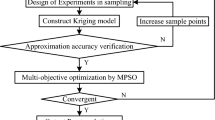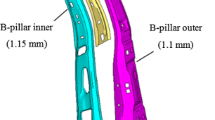Abstract
B-pillar and rocker are the key force transmission sub-systems of the side impact of battery electric vehicle (BEV), and scholars have studied the side crashworthiness of these sub-systems and vehicle body a lot. However, these works are insufficient on the analysis of benchmarking vehicle models, the simulation and experiment of the B-pillar and rocker sub-systems, and the optimization of these sub-systems. To make up these shortcomings, this work aims to design the B-pillar and the rocker and improve the side crashworthiness of BEV. It presents a systematic method on the side crashworthiness of BEV. The dynamic bending performance of the B-pillar and the rocker are studied in simulation analyses and experiments. The materials, structures, and crashworthiness of these two sub-systems of eleven benchmark models are studied. Minimizing structural mass and cost as well as maximizing mean crushing force are performed based on multi-objective artificial tree algorithm to optimize the B-pillar and the rocker. The optimized sub-systems are applied to the body of a BEV. As a result, the performance of the B-pillar and the rocker is significantly improved, and their optimal solution templates are provided. The performance of the BEV is also improved under the advanced European mobile deformable barrier side impact and the oblique pole side impact. Some interesting conclusions for BEV are presented. In summary, this work has obvious reference value for automotive engineers and scholars to further study the crashworthiness and lightweight of BEV.
















Similar content being viewed by others
References
An W, Han X, Tovar A, Wang S (2021) Targeting the acceleration-time response of vehicle structures under crash impact using equivalent dynamic loads. Struct Multidisc Optim 64:599–612
Anselma PG, Niutta CB, Mainini L, Belingardi G (2020) Multidisciplinary design optimization for hybrid electric vehicles: component sizing and multi-fidelity frontal crashworthiness. Struct Multidisc Optim 62(4):2149–2166
Ataabadi PB, Karagiozova D, Alves M (2019) Crushing and energy absorption mechanisms of carbon fiber-epoxy tubes under axial impact. Int J Impact Eng 131:174–189
Berzi L, Baldanzini N, Barbani D, Delogu M, Sala R, Pierini M (2018) Simulation of crash events for an electric four wheel vehicle. Procedia Struct Integr 12:249–264
Biqiang Z, Xiaodong L, Yajun Z (2016) The structure optimization analysis of electric vehicle in small offset rear end collision. Procedia Eng 137:103–108
Chakraborty S, Chatterjee T, Chowdhury R, Adhikari S (2017) Robust design optimization for crashworthiness of vehicle side impact. ASCE-ASME J Risk Uncert Eng Syst Part B: Mech Eng. https://doi.org/10.1115/1.4035439
Du Z, Duan L, Cheng A, Xu Z, Zhang G (2019) Theoretical prediction and crashworthiness optimization of thin-walled structures with single-box multi-cell section under three-point bending loading. Int J Mech Sci 157–158:703–714
Duan L, Jiang H, Cheng A, Xue H, Geng G (2018a) Multi-objective reliability-based design optimization for the VRB-VCS FLB under front-impact collision. Struct Multidisc Optim 59(5):1835–1851
Duan L, Jiang H, Geng G, Zhang X, Li Z (2018b) Parametric modeling and multiobjective crashworthiness design optimization of a new front longitudinal beam. Struct Multidisc Optim 59(5):1789–1812
Duan L, Du Z, Jiang H, Xu W, Li Z (2019) Theoretical prediction and crashworthiness optimization of top-hat thin-walled structures under transverse loading. Thin-Walled Struct 144:106261
Fang J, Qiu N, An X, Xiong F, Sun G, Li Q (2017) Crashworthiness design of a steel–aluminum hybrid rail using multi-response objective-oriented sequential optimization. Adv Eng Softw 112:192–199
Fu CL, Bai YC, Lin C, Wang WW (2019) Design optimization of a newly developed aluminum-steel multi-material electric bus body structure. Struct Multidiscip Optim 60(5):2177–2187
Georgiou G, Zeguer T (2017) On the assessment of the macro-element methodology for full vehicle crashworthiness analysis. Int J Crashworthiness 23(3):336–353
Guan W, Gao G, Yu Y (2021) Crushing analysis and multiobjective crashworthiness optimization of combined shrinking circular tubes under impact loading. Struct Multidisc Optim. https://doi.org/10.1007/s00158-021-02938-8
Hou B, Wang Y, Sun TF, Liu JG, Zhao H (2019) On the quasi-static and impact responses of aluminum honeycomb under combined shear-compression. Int J Impact Eng 131:190–199
Hu L, Hu X, Wang J, Kuang A, Hao W, Lin M (2020) Casualty risk of e-bike rider struck by passenger vehicle using China in-depth accident data. Traffic Inj Prev 21(4):283–287
Hu L, Bao X, Lin M, Yu C, Wang F (2021a) Research on risky driving behavior evaluation model based on CIDAS real data. Proc Inst Mech Eng, Part D: J Automob Eng. https://doi.org/10.1177/0954407020985972
Hu L, Ou J, Huang J, Wang F, Wang Y, Ren B, Peng H, Zhou L (2021b) Safety evaluation of pedestrian-vehicle interaction at signalized intersections in Changsha, China. J Transp Saf Secur. https://doi.org/10.1080/19439962.2021.1960662
Huang S, Qiao P (2020) Buckling of thin-walled I-section laminated composite curved beams. Thin-Walled Struct. https://doi.org/10.1016/j.tws.2020.106843
Huang H, Xu S (2019) Crashworthiness analysis and bionic design of multi-cell tubes under axial and oblique impact loads. Thin-Walled Struct 144:106333
Ikpe AE, Owunna IB, Satope P (2017) Design optimization of a B-pillar for crashworthiness of vehicle side impact. J Mech Eng Sci 11(2):2693–2710
Jung Y, Lim S, Kim J, Min S (2019) Lightweight design of electric bus roof structure using multi-material topology optimisation. Struct Multidisc Optim 61(3):1273–1285
Khatir S, Abdel WM (2019) Fast simulations for solving fracture mechanics inverse problems using POD-RBF XIGA and Jaya algorithm. Eng Fract Mech 205:285–300
Khatir S, Abdel Wahab M, Boutchicha D, Khatir T (2019) Structural health monitoring using modal strain energy damage indicator coupled with teaching-learning-based optimization algorithm and isogoemetric analysis. J Sound Vib 448:230–246
Khatir S, Boutchicha D, Le Thanh C, Tran-Ngoc H, Nguyen TN, Abdel-Wahab M (2020) Improved ANN technique combined with Jaya algorithm for crack identification in plates using XIGA and experimental analysis. Theor Appl Fract Mech 107:102554
Kiani M, Yildiz AR (2016) A comparative study of non-traditional methods for vehicle crashworthiness and NVH optimization. Arch Comput Methods Eng 23(4):723–734
Li QQ, Song K, He ZC, Li E, Cheng AG, Chen T (2017) The artificial tree (AT) algorithm. Eng Appl Artif Intell 65:99–110
Li QQ, He ZC, Li E, Cheng AG (2018) Design and optimization of three-resonator locally resonant metamaterial for impact force mitigation. Smart Mater Struct. https://doi.org/10.1088/1361-665X/aad479
Li QQ, He ZC, Li E, Liu P, Lin XY, Wu Y (2020) Design of resonant structures in resin matrix to mitigate the blast wave with a very wide frequency range. Smart Mater Struct. https://doi.org/10.1088/1361-665X/ab75a4
Li QQ, He ZC, Li E (2020) The feedback artificial tree (FAT) algorithm. Soft Comput 24(17):13413–13440
Li Q, He Z, Li E, Chen T, Wang Q, Cheng A (2020) Development of a multi-objective artificial tree (MOAT) algorithm and its application in acoustic metamaterials. Memet Comput 12(2):165–184
Li QQ, Li E, Chen T, Wu L, Wang GQ, He ZC (2021) Improve the frontal crashworthiness of vehicle through the design of front rail. Thin-Walled Struct 162:107588
Liu J, Liu Q, Han X, Jiang C, Tao Y (2019) A new global sensitivity measure based on derivative-integral and variance decomposition and its application in structural crashworthiness. Struct Multidisc Optim 60(6):2249–2264
Long CR, Yuen SCK, Nurick GN (2019) Analysis of a car door subjected to side pole impact. Lat Am J Solids Struct. https://doi.org/10.1590/1679-78255753
More KC, Patil GM, Belkhede AA (2020) Design and analysis of side door intrusion beam for automotive safety. Thin-Walled Struct 153:106788
Qi C, Sun Y, Hu H-T, Wang D-Z, Cao G-J, Yang S (2016) On design of hybrid material double-hat thin-walled beams under lateral impact. Int J Mech Sci 118:21–35
Song X, Sun G, Li Q (2016) Sensitivity analysis and reliability based design optimization for high-strength steel tailor welded thin-walled structures under crashworthiness. Thin-Walled Struct 109:132–142
Spirk S, Kepka M (2015) Tests and simulations for assessment of electric buses passive safety. Procedia Eng 114:338–345
Sun G, Deng M, Zheng G, Li Q (2019) Design for cost performance of crashworthy structures made of high strength steel. Thin-Walled Struct 138:458–472
Tammareddi S, Sun G, Li Q (2016) Multiobjective robust optimization of coronary stents. Mater Design 90:682–692
Tang B, Wu F, Guo N, Liu J, Ge H, Bruschi S, Li X (2020) Numerical modeling of ductile fracture of hot stamped 22MnB5 boron steel parts in three-point bending. Int J Mech Sci 188:105951
Wang S, Wang D (2019) Research on crashworthiness and lightweight of B-pillar based on MPSO with TOPSIS method. J Braz Soc Mech Sci Eng 41(11):498
Wang Z, Jin X, Li Q, Sun G (2020) On crashworthiness design of hybrid metal-composite structures. Int J Mech Sci. https://doi.org/10.1016/j.ijmecsci.2019.105380
Wang Z, Zhang W, Luo Q, Zheng G, Li Q, Sun G (2020) A novel failure criterion based upon forming limit curve for thermoplastic composites. Compos Part B: Eng 202:108320
Wang T, Li Z, Wang L, Hulbert GM (2020) Crashworthiness analysis and collaborative optimization design for a novel crash-box with re-entrant auxetic core. Struct Multidisc Optim 62(4):2167–2179
Wang W, Dai S, Lu G, Shu J, Wang C, Zhao W, Cao M, Meng Q (2021) Hierarchical optimization of a novel vehicle door system under side impact based on integrated weighting method. Struct Multidisc Optim 63(6):2969–2988
Wu J, Zheng J, Sun G (2021) Experimental and numerical analyses on aluminium alloy H-section members under eccentric cyclic loading. Thin-Walled Struct 162:107532
Xiao Y, Chi H, Li Q (2021) An improved artificial tree algorithm with two populations (IATTP). Eng Appl Artif Intell. https://doi.org/10.1016/j.engappai.2021.104324
Xie C, Wang D (2020) Multi-objective cross-sectional shape and size optimization of S-rail using hybrid multi-criteria decision-making method. Struct Multidisc Optim 62(6):3477–3492
Xu H, Zhang L, Li Q (2019) A novel inverse procedure for load identification based on improved artificial tree algorithm. Eng Comput. https://doi.org/10.1007/s00366-019-00848-4
Yu L, Gu X, Qian L, Jiang P, Wang W, Yu M (2021) Application of tailor rolled blanks in optimum design of pure electric vehicle crashworthiness and lightweight. Thin-Walled Struct 161:107410
Zhang Y, Sun L, Li L, Wang T, Shen L (2019) Experimental and numerical investigations on low-velocity impact response of high strength steel/composite hybrid plate. Int J Impact Eng 123:1–13
Zhao Y, Dong HY, Zhao S, Min S, Cheng J, Li B, Chi F, Liu S (2019) Design of broadband impedance-matching Bessel lens with acoustic metamaterials. J Appl Phys 126(6):065103
Zhou J, Jiang W, Ao Y, Zeng W, Liu J, Mei J, Huang W (2021) The three-point bending responses of carbon fiber composite sandwich beams with Y-frame cores at high and low temperatures. Thin-Walled Struct 162:107595
Zhou G, Yan P, Dai S, Wang Q, Li X, Hao Y, Wang Y (2021) Design optimization for protective shell of hydrogen cylinder for vehicle based on NPR structure. Struct Multidisc Optim 64(1):369–388
Zou T, Shang S, Simms C (2019) Potential benefits of controlled vehicle braking to reduce pedestrian ground contact injuries. Accid Anal Prev 129:94–107
Acknowledgements
This work was supported by the National Science Foundation of China (Grant Number 52005054 and 51875049), the Science Fund of State Key Laboratory of Advanced Design and Manufacturing for Vehicle Body (Grant Number 32015012), and the Hunan Science Foundation for Distinguished Young Scholars of China (Grant Number 2019JJ20017).
Author information
Authors and Affiliations
Corresponding author
Ethics declarations
Conflict of interest
We declare that we do not have any commercial or associative interest that represents a conflict of interest in connection with the work submitted.
Replication of results
The detailed information of the modeling method and the software applied in this paper can be found in the corresponding sections, and the optimization algorithm presented in this work is the reproduction of an already published method. The necessary data of the models can be found in the corresponding text and tables of this paper. Moreover, the stress–strain curves of ultra-high-strength steels DP980, QP980, and DP1180 are available upon request.
Additional information
Responsible Editor: Erdem Acar
Publisher's Note
Springer Nature remains neutral with regard to jurisdictional claims in published maps and institutional affiliations.
Supplementary Information
Below is the link to the electronic supplementary material.
Rights and permissions
About this article
Cite this article
Li, Q., Wu, L., Chen, T. et al. Multi-objective optimization design of B-pillar and rocker sub-systems of battery electric vehicle. Struct Multidisc Optim 64, 3999–4023 (2021). https://doi.org/10.1007/s00158-021-03073-0
Received:
Revised:
Accepted:
Published:
Issue Date:
DOI: https://doi.org/10.1007/s00158-021-03073-0




